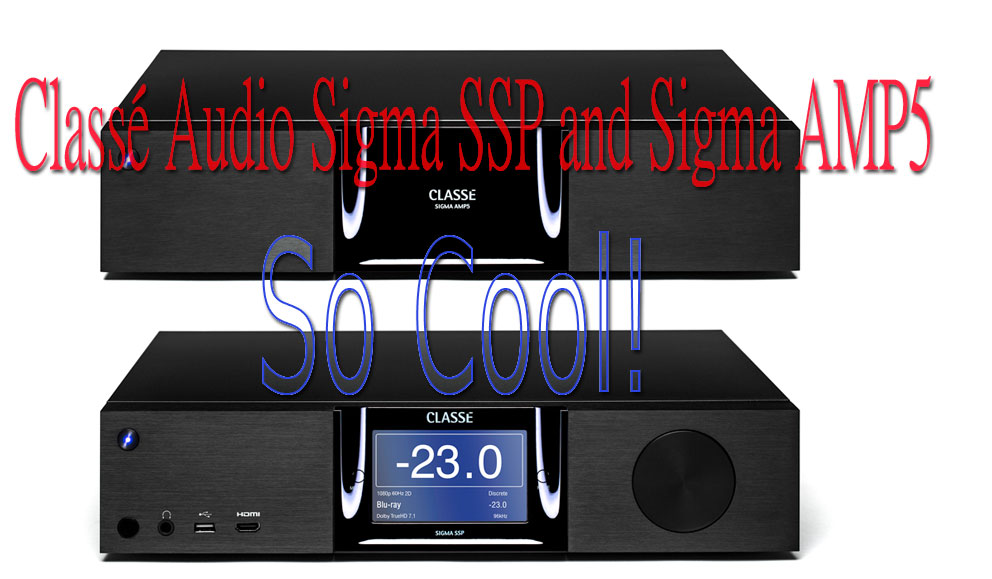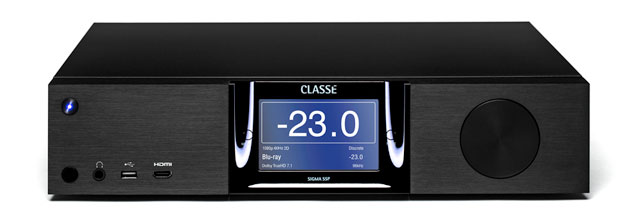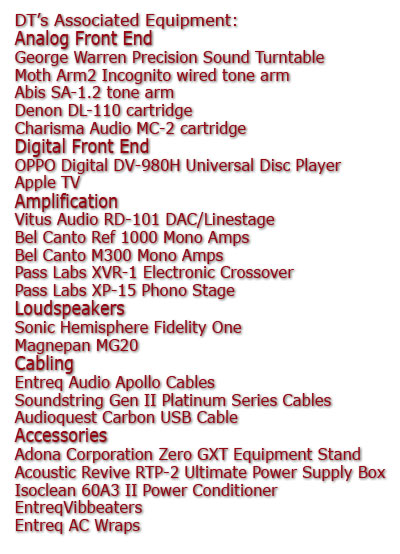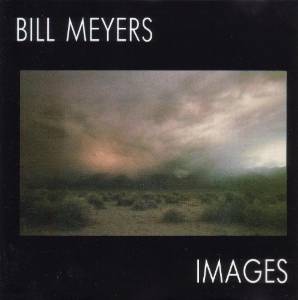Classé Audio Sigma SSP and Sigma AMP5

“Amid the chaos of that day, when all I could hear was the thunder of gunshots, and all I could smell was the violence in the air, I look back and am amazed that my thoughts were so clear and true, that three words went through my mind endlessly, repeating themselves like a broken record: you’re so cool, you’re so cool, you’re so cool.” – Patricia Arquette as Alabama Worley in True Romance.
 Rather than drag out my thoughts on the latest products from Classé Audio, I thought I’d get straight to the point. I loved them. There, I said it. You can go back to watching “Game of Cards” or “House of Thrones” or whatever the TV show du jour is. I’ve saved you the burden of having to wait until you get to the conclusion of this review. But you’d be doing yourself a favor to read on and learn why I think so highly of this equipment. Okay? Great. Let’s move on.
Rather than drag out my thoughts on the latest products from Classé Audio, I thought I’d get straight to the point. I loved them. There, I said it. You can go back to watching “Game of Cards” or “House of Thrones” or whatever the TV show du jour is. I’ve saved you the burden of having to wait until you get to the conclusion of this review. But you’d be doing yourself a favor to read on and learn why I think so highly of this equipment. Okay? Great. Let’s move on.
If you’ve read my reviews of Classé equipment over the years, you’d know that I have always marveled at the way that they consistently produce high-end products. But not only are their products built to the highest standards, they’re always strikingly handsome and state-of-the-art in design. They maximize musicality while still being relatively affordable.
Classé’s new product line is called the Sigma Series. This review is of the Sigma SSP Surround Sound Preamp/Processor and Sigma AMP5 five channel class-D amplifier. There is also a stereo ampcalled the Sigma AMP2 which of course is a class-D stereo amplifier.
Here’s what I love about this company. Most audiophiles are very familiar with Classé’s legendary Omega Series products. They were strikingly handsome and state-of-the-art in design. Then, in an effort to bring a comparable level of performance to a more reasonable price point, they developed the Delta Series products. Again, these components were strikingly handsome and state-of-the-art in design. Now, seemingly in an attempt to bring a comparable level of performance to an even more affordable price point, Classé has developed the Sigma series. Stop me if you’ve heard this: These products are strikingly handsome and state-of-the-art in design.

Sigma SSP
In the movie Men In Black, Will Smith puts on a basic black suit and declares, “I make this look good.” The Classé Sigma products can declare the same thing. I’ve seen many simple looking “black box” audio components but nothing as sleek or elegant looking as this. All Sigma products share the same chassis dimensions: 17” wide x 3.75” high x 14.57” deep. The faceplate featuresa neatly curved cut-out section where an LED display resides. All buttons and knobs are flush mounted to maintain the sleek uncluttered look.
On the front of the SSP you’ll find the “Standby/On Button and Status Indicator LED” in the upper left corner. The power switch for the unit is on the rear panel and when engaged, the LED turns red, which indicates that the unit is in standby mode. Touching the button once or pressing the power button on the remote will turn the LED light blue to indicate that the unit is in operate mode. Below this button is where the infra-red remote control transceiver is located and to the right of it are a ¼” “HEADPHONE” jack, “USB” input and an “HDMI” input. The USB allows for the use of devices such as the iPad, iPod and iPhone to be used as source components. I loved this functionality as I was able to run music from my iTunes library directly into the SSP rather than going over a Wi-Fi network. The HDMI input allows for the connection of a camera or laptop computer.
In the middle of the faceplate is the LED display, which uses large format numbers to make seeing the volume level extremely easy even from more than 20’ away. Frankly, I wish they’d used a slightly smaller volume level font and given us a larger font for the part of the screen where the input selection information is. It can be difficult to read from more than 10’ away. On the left of the display is the “MENU” button and on the right is the “MUTE” button. Finally, on the right side of the faceplate is a large diameter “VOLUME” control knob.

Now, to the rear of the unit. This is where you start to see just how much flexibility you get for your money. I won’t go into detail about everything that is on the back of this unit because frankly, there’s just too much going on. But let’s start in the upper left corner where you’ll find the main power switch and the AC cord input. Below that is where the A/V system “CONTROL” inputs (RS232 and IR remote triggers) are and also the digital inputs (Coaxial, Optical, USB and Ethernet) and outputs (Coaxial). To the right are a bank of “ANALOG AUDIO INPUTS” (XLR and RCA) and “ANALOG AUDIO OUTPUTS” (XLR and RCA). Above these connections are a bank of seven “HDMI” inputs and finally, a single “HDMI OUTPUT.” All totaled that’s seven digital inputs, one digital output, three sets of analog audio inputs, and ten analog audio outputs. Among these ten outputs there are two sets of left and right front main outputs (XLR and RCA) and two AUX outputs. The remaining four outputs are of course for the center channel, subwoofer, and left and right side channels. Additionally, the seven HDMI inputs allow you to accommodate multiple 2D and 3D video format sources. Like I said, there’s a lot going on back here. I also learned from Classé Audio chief Dave Nauber that a phono stage option is now available. It can be installed by a local dealer for $500.00 (USD) plus two hours labor. It’s the same MM/MC phono stage that is available for the Delta series CP-800 Stereo Preamp/Processor.
Again, I used these components primarily in a two-channel audio configuration, so I won’t try to comment on the system’s video or multi-channel capabilities. After all, our webzine is called “Stereo” Times. But it was obvious even to me that this system offers an enormous amount of flexibility for those who take their video as seriously as they do their audio.

Sigma AMP5

When I was offered the opportunity to review these products, I was most keen on spending time with the AMP5, for a couple of reasons. First, I’m currently using class-D amplification on my Maggie MG20s and have never been happier with my system than I am right now. I’m using a pair of Bel Canto M300 mono amps on the high frequency ribbon tweeters of the MG20s and Bel Canto REF1000M mono amps on the low frequency panels. And second, needing four channels of amplification and literally using one amplifier box for each individual channel is not without its challenges, so this was a great opportunity to see what being able to provide amplification to a demanding pair of speakers from a single box of amplification was intriguing to me.
Aesthetically speaking the AMP5 is identical to the SSP except there are no inputs on the front panel, and only the “Standby/On Button and Status Indicator LED” is the same.On the rear of the AMP5 the first thing I noticed was the USB “Update Host” connector which is used to install firmware updates to the amp from a USB stick. It’s nice to know that your amp can be future proofed with software updates. It assures the longevity of the equipment. To the right of that are the A/V system connectivity connections. Below that are an AC mains fuse holder, AC cord receptacle and the audio “INPUTS.” The first two channels of the AMP5 are available as both XLR and RCA connections. The other four channels are RCA only. This means for someone like me who is still very much a two-channel only guy, that I can use the balanced outputs of the SSP into the balanced inputs of the AMP5, thereby operating in a fully balanced stereo configuration. Finally, on the right side of the rear are five sets of high quality five-way binding posts.
There is one small quibble that I have with the build of the Sigma units and that is the very sharp edges and corners of the faceplates. Keep the kiddies away folks. These corners will do some serious damage to a human forehead. Maybe I’ve been too use to the smooth curves of the Delta Series components, but these edges make me a bit wary.
System Setup and Sound
Now I realize that the SSP is designed as a multi-channel processor/preamp and the AMP5 can obviously be used for up to five channels, but the beauty in these products is that they can also be used as a two-channel preamp and stereo amp, which is how I used them except with a little twist. You see my Maggie MG20s require four channels of amplification to be used with my Pass Labs XVR-1 electronic crossover. So I was basically bi-amping my speakers with a single multi-channel amp. And at 200 watts per channel, I was basically feeding the Maggies 400 watts per channel.
My source components were the OPPO Digital DV-980H disc player, Apple TV streaming device and George Warren turntable. The OPPO and the Apple TV both connected to the SSP via fiber optic cable connections while the turntable connected via the Pass Labs XP-15 phonostage. All cabling was the very neutral Soundstring Gen II Platinum.
Listening commenced with the George Warren turntable. But in this case, my usual Moth Arm2 and Denon DL-110 cartridge have been replaced and, might I add, upgraded to the Abis SA-1.2 tonearm and Charisma Audio MC-2 moving coil cartridge. Reviews of each of these pieces will be coming soon, so I will save any detailed discussion on them until then.
 Bill Meyer’s Images [Spindletop Records] was the first album I listened to and it was immediately apparent that the Sigma products were indeed as musically satisfying as you would expect from Classé. This is one of the best recorded albums I own and with musicians like guitarist Larry Carlton and saxophonist Ernie Watts joining keyboardist Meyers, there are scads of musical details and nuances to be enjoyed. The preamp section of the SSP is excellent but the power and control from the four channels I used of the AMP5 were jaw-dropping. The MG20s are no cake walk to drive but the AMP5 did so without even a hint of stress or strain. Instead, all of the drive, rhythm and attack that this recording is known for were there in spades. The first two tracks on the A-side of this album is called AM and PM. They are literally the soundtrack for my daily life. AM starts with an alarm clock going off and the up-tempo music that follows is exactly the kind of thing that gets me moving in the morning, and fast. The Classé system would need to be very light on its feet to reproduce this music with the speed clarity that is needed while still being able to create all of the depth and spaciousness of the percussive instruments that are played. PM, of course, is music that winds down the day. It’s smoother and less dynamic than AM but actually draws you more into Meyers deft play on keyboards, which is a treat. In either case, the Sigma gear works phenomenally well.
Bill Meyer’s Images [Spindletop Records] was the first album I listened to and it was immediately apparent that the Sigma products were indeed as musically satisfying as you would expect from Classé. This is one of the best recorded albums I own and with musicians like guitarist Larry Carlton and saxophonist Ernie Watts joining keyboardist Meyers, there are scads of musical details and nuances to be enjoyed. The preamp section of the SSP is excellent but the power and control from the four channels I used of the AMP5 were jaw-dropping. The MG20s are no cake walk to drive but the AMP5 did so without even a hint of stress or strain. Instead, all of the drive, rhythm and attack that this recording is known for were there in spades. The first two tracks on the A-side of this album is called AM and PM. They are literally the soundtrack for my daily life. AM starts with an alarm clock going off and the up-tempo music that follows is exactly the kind of thing that gets me moving in the morning, and fast. The Classé system would need to be very light on its feet to reproduce this music with the speed clarity that is needed while still being able to create all of the depth and spaciousness of the percussive instruments that are played. PM, of course, is music that winds down the day. It’s smoother and less dynamic than AM but actually draws you more into Meyers deft play on keyboards, which is a treat. In either case, the Sigma gear works phenomenally well.
 But I don’t mean to imply that these products favor dynamic music.What they did with the subtleties of an intimate live recording was at least equally impressive. My current favorite live CD is Gretchen Parlato’s Live In NYC [Obliq Sound Records]. The sultry songstress has blown me away with one of the smoothest and unique voices I’ve ever heard. It was going to be crucial for the Classé gear to do her voice justice. The opening track on this disc is “Butterfly.” The song opens with the initial applause and then Parlato begins to scat and use her delicate little hands as an acoustic instrument. Slowly piano cues and a few strums of an upright bass joins in as she begins to sing. So much takes place during that intro that it draws you into not just that track but the rest of the live performance as well. The SSP and AMP5 combine to render voices, instruments and spaces with a good balance of realism and musicality.
But I don’t mean to imply that these products favor dynamic music.What they did with the subtleties of an intimate live recording was at least equally impressive. My current favorite live CD is Gretchen Parlato’s Live In NYC [Obliq Sound Records]. The sultry songstress has blown me away with one of the smoothest and unique voices I’ve ever heard. It was going to be crucial for the Classé gear to do her voice justice. The opening track on this disc is “Butterfly.” The song opens with the initial applause and then Parlato begins to scat and use her delicate little hands as an acoustic instrument. Slowly piano cues and a few strums of an upright bass joins in as she begins to sing. So much takes place during that intro that it draws you into not just that track but the rest of the live performance as well. The SSP and AMP5 combine to render voices, instruments and spaces with a good balance of realism and musicality.
Another recording that I’ve been getting into a lot lately is Robert Glasper’s Black Radio [Blue Note]. Track 3, is Lalah Hathaway singing a cover of Sade’s melodic “Cherish the Day.” It is one of those recordings that shows the true value of good amplification. Hathaway’s soulful and powerful voice almost get overwhelmed by the over engineering done on this recording. On mediocre electronics this track can be particularly annoying but with the SSP and AMP5 it sounds how I imagine Glasper intended it: musically multi-layered. Glasper’s band is brilliant and does a great job of not dominating her voice while still managing to sound like a true R&B recording. The AMP5’s ability to relay a grain-free soundstage allows you to enjoy Hathaway’s voice and the brilliant musicianship of Glasper’s band.
A Quick Comparison
I ordinarily don’t like to do direct comparisons of gear that don’t have much in common. But in this case, well, I just couldn’t help myself. I had to compare the AMP5 to my reference Bel Canto mono amps. One chassis, four channels vs. four chassis, four channels. Obviously, there are things to prefer about the Sigma amp right away. The AMP5 is less expensive and gives me one extra channel that can be used on a subwoofer. The AMP5 can save me a ton of dough on interconnect cables and AC cords. And as I said earlier, the AMP5 is strikingly handsome and… well, you know. But the real comparison comes in each system’s ability to render music. The results were kind of surprising in that I never noticed that much of a difference. Maybe it was because it was all class-D amplification but the ability to reproduce scale and nuance of instruments was quite similar. Maybe the Bel Canto amps were slightly more dynamic at higher volume levels but not by much. And frankly, the M300 amps showed their age compared to the AMP5 when rendering live vocals. This was very much in evidence on the Gretchen Parlato recording. This is impressive stuff for a five channel amp.
Conclusion
The Classé Audio Sigma SSP and Sigma AMP5 are really what I would call “every man” components. Their understated, sleek looks and ability to render fine musical details will appeal to audiophiles with refined (to them) musical tastes, while movie and music lovers will love the numerous input and output options and the fact that the system can easily handle just about any kind of music. While not cheap by any stretch, if you’ve gone so far as to be reading reviews from publications like ours, you know that their price tag makes them a pretty darn good bargain. And you know what I say to that? That’s so cool, that’s so cool, that’s so cool. Highly recommended.


dave thomas
Specifications:
Sigma SSP
· USB audio: up to 24-bit/192 kHz
· USB (Host): charging capability 2 Amps
· AirPlay Surround Formats: AAC (8 to 320 kbps) Protected AAC (from iTunes Store); HE-AAC; MP3 (8 to 320 kbps); MP3 VBR; Audible (formats 2, 3, 4) Audible Enhanced Audio (AAX, and AAX+); Apple Lossless; AIFF; WAV
· DLNA Supported Formats: Apple Lossless (ALAC), mp3, FLAC, WAV, OggVorbis, WMA, AAC
· Frequency response: 8 Hz – 200 kHz < 1 dB, stereo digital bypass 8 Hz – 20 kHz < 0.5 dB, all other sources
· Channel Matching (Left to Right): better than 0.05 dB
· Distortion (THD+noise): 0.0005%, digital source/bypassed analog source .002%, processed analog source
· Maximum Input Level (Single-Ended): 2 Vrms (DSP), 4.5Vrms (bypass)
· Maximum Input Level (Balanced): 4 Vrms (DSP), 9 Vrms (bypass)
· Maximum Output Level (Single-Ended): 9 Vrms
· Maximum Output Level (Balanced): 18 Vrms
· Gain Range: -93 dB to +14 dB
· Input impedance (single-ended): 100 kΩ (single-ended)
· Input impedance (balanced): 50 kΩ (Balanced)
· Output impedance (single-ended): 100 Ω
· Output impedance (balanced): 300 Ω
· Signal-to-noise ratio (ref. 4Vrms input, unweighted): 104 dB, bypassed analog source 101 dB, processed analog source (re. full-scale input, unweighted) 105 dB, digital source
· Channel separation: better than 100 dB
· Channel matching (left to right): >0.05 dB
· Crosstalk (any input to any output): better than -130 dB @ 1 kHz
· Rated power consumption: 35 W
· Mains voltage: 100-240 V, 50/60 Hz
· Compatibility
· Made for iPod touch (5th generation) iPod nano (7th generation) iPod touch (4th generation) iPod nano (6th generation) iPod touch (3rd generation) iPod nano (5th generation) iPod touch (2nd generation) iPod nano (4th generation) iPod touch (1st generation) iPod nano (3rd generation)
· Made for iPhone 5S iPhone 3GS iPhone 5 iPhone 3G iPhone 4S iPhone iPhone 4
· Made for iPad mini (with Retina display) iPad (3rd generation) iPad Air iPad 2 iPad (4th generation) iPad iPad mini
· Airplay AirPlay works with iPhone, iPod, and iPod touch with iOS 4.3.3 or later, Mac with OS X Mountain Lion, and Mac and PC with iTunes 10.2.2 or later.
· Approximate Dimensions:
· Height: 3.75″
· Width: 14.57”
· Depth: 17″
· Approximate Weight:
· Unit: 18 lbs
· Shipping: 25 lbs
· Price: $5,000.00
Sigma AMP5
· Frequency response: 10Hz – 20kHz, -1dB into 4Ω
· Output power: 200W rms into 8Ω All channels driven 400W rms into 4Ω Any two channels driven*
Harmonic Distortion: 0.018% @ 1kHz All channelsdriven to 1/8th power into
Peak Output Voltage: 116V peak to peak, 58V rms no load 116V peak to peak, 58V rms into 8Ω
· Input Impedance: 100kΩ Balanced / 50kΩ SE
· Voltage gain: 29 dB
· Input level at clipping: 1.4Vrms Balanced/SE
· Intermodulation Distortion:>80 dB below fundamental into 8Ω SE
· Signal to Noise Ratio: -100 dB at peak output into 8Ω (AES17)
· Rated power consumption: 200W @ 1/8th power into 8Ω
· Mains voltage: 100V – 240V, 50/60Hz
· Approximate Dimensions:
· Height: 3.75″
· Width: 17″
· Depth: 14.57″
· Approximate Weight:
· Unit: 23 lbs
· Shipping: 30 lbs
· Price: $5,000.00
Contact:
Classé
5070 François Cusson
Lachine, QC H8T1B3
Canada
Website: http://www.classeaudio.com
Stereo Times Masthead
Publisher/Founder
Clement Perry
Editor
Dave Thomas
Senior Editors
Frank Alles, Mike Girardi, Key Kim, Russell Lichter, Terry London, Moreno Mitchell, Paul Szabady, Bill Wells, Mike Wright, Stephen Yan, and Rob Dockery
Current Contributors
David Abramson, Tim Barrall, Dave Allison, Ron Cook, Lewis Dardick, Dan Secula, Don Shaulis, Greg Simmons, Eric Teh, Greg Voth, Richard Willie, Ed Van Winkle, and Rob Dockery
Music Reviewers:
Carlos Sanchez, John Jonczyk, John Sprung and Russell Lichter
Site Management Clement Perry
Ad Designer: Martin Perry






Be the first to comment on: Classé Audio Sigma SSP and Sigma AMP5